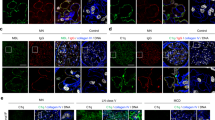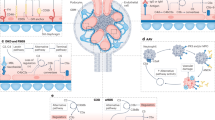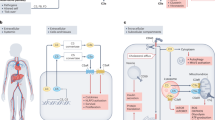Abstract
The alternative pathway of complement is activated continuously in vivo through the C3 'tick-over' pathway1. This pathway is triggered by the hydrolysis of C3, resulting in the formation of C3 convertase. This, in turn, generates C3b, which mediates many of the biological functions of complement. Factor H, the main regulator of this activation, prevents formation and promotes dissociation of the C3 convertase enzyme2,3, and, together with factor I, mediates the proteolytic inactivation of C3b4. Factor H deficiency, described in 29 individuals from 12 families5,6,7,8,9,10,11,12,13,14 and in pigs15, allows unhindered activation of fluid-phase C3 and severe depletion of plasma C3 (ref. 11). Membranoproliferative glomerulonephritis (MPGN) occurs in factor H–deficient humans6,12,13 and pigs15. Although MPGN has been reported in other conditions in which uncontrolled activation of C3 occurs, the role of C3 dysregulation in the pathogenesis of MPGN is not understood. Here we show that mice deficient in factor H (Cfh−/− mice) develop MPGN spontaneously and are hypersensitive to developing renal injury caused by immune complexes. Introducing a second mutation in the gene encoding complement factor B, which prevents C3 turnover in vivo, obviates the phenotype of Cfh−/− mice. Thus, uncontrolled C3 activation in vivo is essential for the development of MPGN associated with deficiency of factor H.
This is a preview of subscription content, access via your institution
Access options
Subscribe to this journal
Receive 12 print issues and online access
$209.00 per year
only $17.42 per issue
Buy this article
- Purchase on Springer Link
- Instant access to full article PDF
Prices may be subject to local taxes which are calculated during checkout




Similar content being viewed by others
References
Pangburn, M.K. & Muller-Eberhard, H.J. Relation of putative thioester bond in C3 to activation of the alternative pathway and the binding of C3b to biological targets of complement. J. Exp. Med. 152, 1102–1114 (1980).
Pangburn, M.K. & Muller-Eberhard, H.J. Complement C3 convertase: cell surface restriction of β1H control and generation of restriction on neuraminidase-treated cells. Proc. Natl Acad. Sci. USA 75, 2416–2420 (1978).
Weiler, J.M., Daha, M.R., Austen, K.F. & Fearon, D.T. Control of the amplification convertase of complement by the plasma protein β1H. Proc. Natl Acad. Sci. USA 73, 3268–3272 (1976).
Pangburn, M.K., Schreiber, R.D. & Muller-Eberhard, H.J. Human complement C3b inactivator: isolation, characterization, and demonstration of an absolute requirement for the serum protein β1H for cleavage of C3b and C4b in solution. J. Exp. Med. 146, 257–270 (1977).
Vogt, B.A., Wyatt, R.J., Burke, B.A., Simonton, S.C. & Kashtan, C.E. Inherited factor H deficiency and collagen type III glomerulopathy. Pediatr. Nephrol. 9, 11–15 (1995).
Rougier, N. et al. Human complement factor H deficiency associated with hemolytic uremic syndrome. J. Am. Soc. Nephrol. 9, 2318–2326 (1998).
Ohali, M. et al. Hypocomplementemic autosomal recessive hemolytic uremic syndrome with decreased factor H. Pediatr. Nephrol. 12, 619–624 (1998).
Fijen, C.A. et al. Heterozygous and homozygous factor H deficiency states in a Dutch family. Clin. Exp. Immunol. 105, 511–516 (1996).
Nielsen, H.E. et al. Hereditary, complete deficiency of complement factor H associated with recurrent meningococcal disease. Scand. J. Immunol. 30, 711–718 (1989).
Pichette, V. et al. Familial hemolytic-uremic syndrome and homozygous factor H deficiency. Am. J. Kidney Dis. 24, 936–941 (1994).
Thompson, R.A. & Winterborn, M.H. Hypocomplementaemia due to a genetic deficiency of β1H globulin. Clin. Exp. Immunol. 46, 110–119 (1981).
Levy, M. et al. H deficiency in two brothers with atypical dense intramembranous deposit disease. Kidney Int. 30, 949–956 (1986).
Lopez-Larrea, C. et al. A familial deficiency of complement factor H. Biochem. Soc. Trans. 15, 648–649 (1987).
Brai, M., Misiano, G., Maringhini, S., Cutaja, I. & Hauptmann, G. Combined homozygous factor H and heterozygous C2 deficiency in an Italian family. J. Clin. Immunol. 8, 50–56 (1988).
Hogasen, K., Jansen, J.H., Mollnes, T.E., Hovdenes, J. & Harboe, M. Hereditary porcine membranoproliferative glomerulonephritis type II is caused by factor H deficiency. J. Clin. Invest. 95, 1054–1061 (1995).
Matsumoto, M. et al. Abrogation of the alternative complement pathway by targeted deletion of murine factor B. Proc. Natl Acad. Sci. USA 94, 8720–8725 (1997).
Alexander, J.J., Hack, B.K., Cunningham, P.N. & Quigg, R.J. A protein with characteristics of factor H is present on rodent platelets and functions as the immune adherence receptor. J. Biol. Chem. 276, 32129–32135 (2001).
Spitzer, R.E. et al. Serum C′3 lytic system in patients with glomerulonephritis. Science 164, 436–437 (1969).
Daha, M.R., Fearon, D.T. & Austen, K.F. C3 Nephritic factor (C3NeF): stabilization of fluid phase and cell-bound alternative pathway convertase. J. Immunol. 116, 1–7 (1976).
Galle, P. & Mahieu, P. Electron dense alteration of kidney basement membranes. A renal lesion specific of a systemic disease. Am. J. Med. 58, 749–764 (1975).
Berger, J. & Galle, P. Alteration singuliere des membranes basales du rein. J. Urol. Nephrol. 68, 116–122 (1962).
West, C.D., Witte, D.P. & McAdams, A.J. Composition of nephritic factor-generated glomerular deposits in membranoproliferative glomerulonephritis type 2. Am. J. Kidney Dis. 37, 1120–1130 (2001).
West, C.D. & McAdams, A.J. Paramesangial glomerular deposits in membranoproliferative glomerulonephritis type II correlate with hypocomplementemia. Am. J. Kidney Dis. 25, 853–861 (1995).
Verroust, P.J., Wilson, C.B. & Dixon, F.J. Lack of nephritogenicity of systemic activation of the alternate complement pathway. Kidney Int. 6, 157–169 (1974).
Simpson, I.J., Moran, J., Evans, D.J. & Peters, D.K. Prolonged complement activation in mice. Kidney Int. 13, 467–471 (1978).
Droz, D., Nabarra, B., Noel, L.H., Leibowitch, J. & Crosnier, J. Recurrence of dense deposits in transplanted kidneys: I. Sequential survey of the lesions. Kidney Int. 15, 386–395 (1979).
Vik, D.P., Keeney, J.B., Munoz-Canoves, P., Chaplin, D.D. & Tack, B.F. Structure of the murine factor H gene. J. Biol. Chem. 263, 16720–16724 (1988).
Woodrow, D.F., Shore, I., Moss, J., Gower, P. & Phillips, M. Immunoelectron microscopic studies of immune complex deposits and basement membrane components in IgA nephropathy. J. Pathol. 157, 47–57 (1989).
Robson, M.G. et al. Accelerated nephrotoxic nephritis is exacerbated in C1q-deficient mice. J. Immunol. 166, 6820–6828 (2001).
Pepys, M.B., Dash, A.C., Fielder, A.H. & Mirjah, D.D. Isolation and study of murine C3. Immunology 33, 491–499 (1977).
Acknowledgements
We thank M. Lewis and I. Shore for processing the samples for histology and electron microscopy; J. Meek for the serum albumin and creatinine analysis; R.B. Sim for help with western blotting of factor H; H. Colten for factor B–deficient mice; B.P. Morgan for the antibody against C9; and M.R. Daha for the antibody against factor H. M.C.P. is funded by the Arthritis Research Campaign. This work was also supported by the Wellcome trust.
Author information
Authors and Affiliations
Corresponding author
Ethics declarations
Competing interests
The authors declare no competing financial interests.
Rights and permissions
About this article
Cite this article
Pickering, M., Cook, H., Warren, J. et al. Uncontrolled C3 activation causes membranoproliferative glomerulonephritis in mice deficient in complement factor H. Nat Genet 31, 424–428 (2002). https://doi.org/10.1038/ng912
Received:
Accepted:
Published:
Issue Date:
DOI: https://doi.org/10.1038/ng912
This article is cited by
-
Complement factor H Y402H polymorphism results in diminishing CD4+ T cells and increasing C-reactive protein in plasma
Scientific Reports (2023)
-
Successful treatment with avacopan (CCX168) in a pediatric patient with C3 glomerulonephritis
Pediatric Nephrology (2023)
-
A clinical approach to children with C3 glomerulopathy
Pediatric Nephrology (2022)
-
Amnion epithelial cells are an effective source of factor H and prevent kidney complement deposition in factor H-deficient mice
Stem Cell Research & Therapy (2021)
-
Complement in metabolic disease: metaflammation and a two-edged sword
Seminars in Immunopathology (2021)



